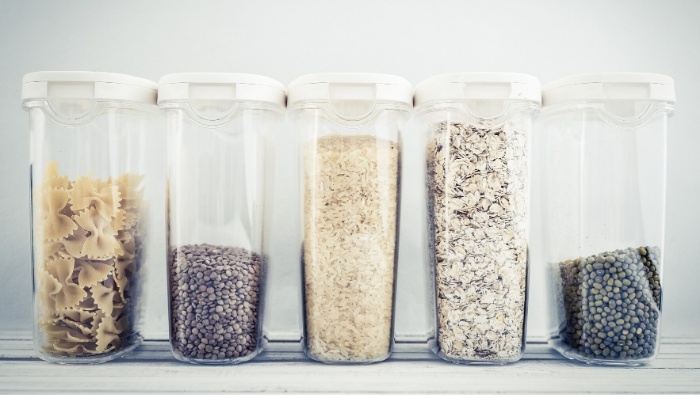Food Storage Practices That Reduce Food Waste

With billions in food waste yearly, it’s time to do something about it. These food storage practices can help you reduce your food bills by as much as $500 per year!
When my mother sold her house and moved into a retirement home, I helped with a number of tasks, among them cleaning out the refrigerator and chest freezer. As I cleaned out both appliances, I discovered that very few items needed to be thrown out. In fact, our friends and neighbors benefited as I distributed many carefully wrapped and well-preserved food items.
My mother’s meticulous attention to detail had definitely paid off. Here are some of her food storage tips:
Carefully Position All Food Items in the Fridge
Eggs, dairy products, sandwich meats, leftovers, and cakes should be stored on the middle and top shelves. The compartments on the inside of the door are the warmest part of the fridge and are intended for drinks, mustard, relish and other products that require light refrigeration. The coldest point is the bottom shelf and the drawers used for vegetables. Place your fresh meat and fish here; this will prevent them from dripping onto other foods.
Make a Freezer Map
Map out where you want to store certain food groups in the chest freezer. Tape this map to the side of the freezer and refer to it often. This will save you time and frustration while hunting for specific food items.
Keep frequently used frozen items like breakfast foods and juices in the freezer’s door.
Sign Up for Savings
Subscribe to get money-saving content by email that can help you stretch your dollars further.
Twice each week, you'll receive articles and tips that can help you free up and keep more of your hard-earned money, even on the tightest of budgets.
We respect your privacy. Unsubscribe at any time.
Be Mindful About New Purchase Placement
Place recently purchased items behind items that are already there.
This will ensure that you are consuming foods prior to their expiration dates and help reduce the amount of food that has to be discarded. Clearly label all freezer packages. Include the name of each item and the date you place it in the freezer. Use a pencil or crayon; ink and felt-tip pen marks can easily fade and smudge.
Place your older frozen goods toward the top of your freezer. Check freezing guidelines and try to use up the food items within three to six months.
Wrap and Store Food Carefully
Rewrap any meat, fish, poultry, and cold cuts that come in flimsy wrapping, especially if you will be storing them for a few days.
Remove All the Air
If you are using plastic bags, squeeze out as much air as possible and ensure that the bags are properly sealed.
With plastic containers, match the size of the container as close as possible to the contents. If there is too much space at the top of the container, spoilage and freezer burn can result. If you do not leave sufficient headroom, the lid could pop off the container, or the container could split open.
Prevent Foul Odors From Forming and Spreading
Clean the fridge and chest freezer regularly. While the fridge could easily be done in less than an hour, you may need a few hours or an entire afternoon to clean out a freezer properly.
Start by removing all food items and discarding any questionable items. Add two tablespoons of baking soda to one quart of warm water. Carefully scrub the interior, including the shelves, doors and the gasket lining the door. Create another mixture using one tablespoon of unscented liquid bleach and a gallon of warm water. Scrub, using this mixture, to disinfect all surfaces. Leave the freezer open for 15 minutes. Open the windows in the room and point a fan toward the freezer. Check for any lingering odors.
These simple changes in food storage practices can significantly help reduce food waste in our homes and communities.
According to RTS.com, 80 billion pounds of food goes to waste in the U.S. each year. That “equates to 219 pounds of waste per person. ” And “food is the single largest component taking up space inside US landfills.”
This is definitely food for thought.
Reviewed November 2023
About the Author
For 31 years, Joanne Guidoccio taught mathematics, computer science, business and career education courses in secondary schools throughout Ontario. Her articles, book reviews, and short stories have been published in Canadian newspapers and online. She has bachelor's degrees in mathematics and education and a Career Development Practitioner diploma.
Wouldn't you like to be a Stretcher too?
Subscribe to get our money-saving content twice per week by email and start living better for less.
We respect your privacy. Unsubscribe at any time.


